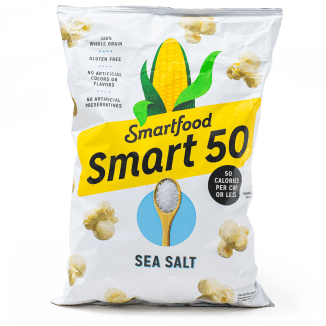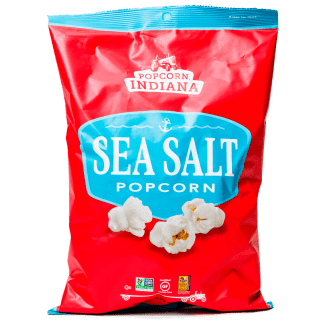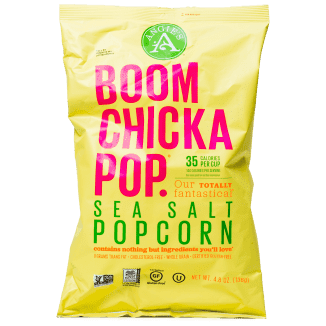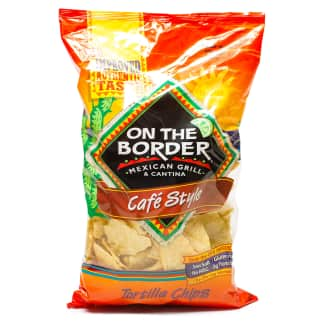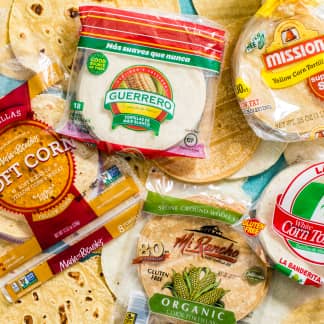Americans have been crazy about popcorn since the Great Depression, when it became popular as a cheap, filling, and nutritious snack. These days, popcorn comes in all shapes, sizes, and flavors—from kernels you pop on the stovetop to buttery microwavable products and even mail-order heirloom varieties. But we’ve had our eye on a different category that’s exploded over the past few years: bagged popcorn.
While sales of microwave and kernel popcorn have slowly declined, bagged popcorn sales have increased 60 percent since 2012. We rounded up seven top-selling, nationally available varieties of bagged popcorn to see if we could find a favorite. Though most brands offer multiple flavors, we stuck with basic salt-and-oil varieties. Twenty-one America’s Test Kitchen staffers sampled the popcorns side by side in a blind, randomized tasting.
Though all the products consisted of just oil, salt, and popcorn kernels, tasters noted clear differences between samples: Some were toasty, nutty, and slightly sweet, while others tasted bland, flat, or even a bit burnt. Examining ingredient labels, we saw no trend in type or amount of oil or type of popcorn (all labels just listed “popcorn”).

But the salt was another story. The top products contained a moderate amount of sodium—about 110 milligrams per 1-ounce serving—compared to the 220 milligrams in middle-of-the-pack popcorns and as little as 75 milligrams in the lowest-ranked samples. Products with too little salt were deemed “muted,” while those with too much lacked nuanced toasted-corn flavor. We preferred those with moderate levels of sodium, which allowed the subtleties of the popcorn to shine.
Tasters cared about texture and showed a clear preference for certain samples, so we went in search of answers. All popcorn pops the same way. As the kernels are heated, water inside them begins to steam, building up pressure and causing starch in the kernels to gelatinize. Once enough pressure builds up, the foamy starch bursts through the tough outer layer of the kernels and solidifies as it hits the air—that’s the whitish, billowy part of popped kernels.

To learn more about the factors that affect how popcorn pops, we reached out to food scientists at the University of Nebraska–Lincoln (UNL). They told us that a number of factors could impact pop: a kernel’s size, moisture content, or breed; how the kernels are stored; and how they’re heated. Unfortunately, manufacturers weren’t willing to disclose specifics about their processes or kernels.
Looking for more clues, we scrutinized the popcorn pieces. Tasters preferred round, hearty pieces. UNL scientists told us that the popcorn industry categorizes popped kernels into three different shapes: unilateral (pieces that expand in one direction), bilateral (pieces that expand in two directions), or multilateral (pieces that expand in three or more directions). Unilateral popcorn pieces are the easiest to spot; they can resemble little octopuses, with dense, round bodies and appendages extending from the bodies on one side. Bilateral pieces are long, flat, and often symmetrical. Multilateral pieces are large and airy, with at least three appendages stemming from the bodies. Using a visual guide provided by David Jackson, a researcher at UNL, we counted out 100 pieces from each popcorn in our lineup and sorted them according to shape.
Test Kitchen Discovery: Popcorn Shapes
The popcorn industry categorizes popped kernels into three basic shapes: Unilateral (pieces that expand in one direction), bilateral (pieces that expand in two directions), and multilateral (pieces that expand in three or more directions). The best popcorns have the highest percentage of unilateral pieces, which are perceived as crunchier and more substantial. In the photos above, picture the raw kernel in the center of each popped piece.
UNILATERAL
Less expansion makes a denser, crunchier texture.
BILATERAL
A double blow-out makes for a “squishier” texture.
MULTILATERAL
Too much expansion weakens the crunch.
The result: Top-ranked popcorns contained more than 50 percent unilateral pieces, while the lowest-ranked sample had a paltry 4 percent. Tasters perceived products with a high percentage of unilateral pieces to be crunchier and more substantial, while they commented that those with fewer unilateral pieces were “spongy.”
The results mirror one UNL study, which found that consumers preferred unilateral pieces in microwave popcorn, rating them as being crispier than other shapes. While researchers are still exploring consumer popcorn preferences, our tasters strongly preferred the dense, crunchy texture of unilateral pieces.
Our favorite was Cape Cod Sea Salt Popcorn. Tasters found this popcorn, which is made up of half unilateral pieces, crisp and substantial, with a balanced, fresh flavor. In fact, when we tasted it against homemade popcorn, tasters found the two surprisingly similar. You will pay for the convenience of bagged popcorn: Our winner costs more per ounce of kernels compared to home-popped. But it’s a great no-cook shortcut that’s surprisingly similar to homemade.
Unfortunately, after this story was published, our winning bagged popcorn by Cape Cod was discontinued. Our top recommendation is now the Smartfood Delight Sea Salt Popcorn.
- Taste plain, from freshly opened packages
- Compare nutritional labels
- Sort kernels by shape
- Pit winner against freshly popped stovetop popcorn
- Moderate amount of salt
- Big, crunchy, round pieces, known in the popcorn industry as “unilateral”

